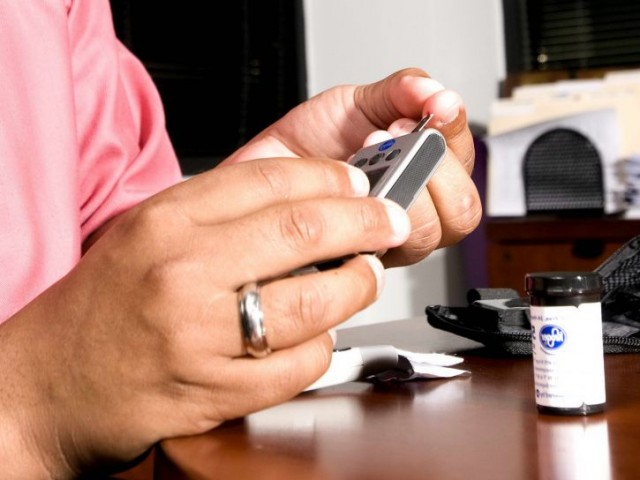July 2007 - Inhaled insulin, taken before meals, can improve blood glucose control for people with type 2 diabetes who have not had good results with short-acting injected insulin that is taken in addition to the baseline insulin administered throughout the day and night, according to a new review of the body of published research.
People who use insulin to manage their type 2 diabetes typically have to take extra insulin at mealtimes to regulate the glucose response to food. They can use short-acting injected insulin or inhaled insulin.
The review examined several clinical issues surrounding the use of inhaled insulin by patients with type 2 diabetes. It looked at how inhaled insulin compares to injected insulin as a mealtime insulin supplement for patients who are already using injected insulin daily.
The report also compared use of inhaled insulin by type 2 diabetes patients who had not previously taken insulin in any form. Inhaled insulin was compared to the effectiveness of oral antidiabetic drugs used alone and to antidiabetic drugs used with inhaled insulin.
In patients with type 2 diabetes, inhaled insulin worked as well as short-acting injected insulin to control blood glucose over three months, according to the review. However, inhaled insulin users had more trouble controlling low blood glucose � hypoglycemia �a common complication of diabetes medication.
Continue Reading Below ↓↓↓
"Insulin is associated with hypoglycemia," said John Buse, M.D., president-elect of the American Diabetes Association. "That is its most common and potentially serious complication in all of its formulations."
Among patients who had not previously taken insulin in any form, inhaled insulin alone was more effective than oral diabetes medication at controlling blood glucose levels at the three-month follow-up. When patients took oral medication plus inhaled insulin, higher rates of hypoglycemia occurred.
The Windows on Medical Technology report is published by ECRI Institute, an independent nonprofit health services research agency that researches the best approaches to improving patient care. The institute produces systematic reviews on medical devices, drugs, biotechnologies, procedures, and health services.
Jonathan Treadwell, Ph.D., senior research analyst at ECRI Institute, led a team of investigators who analyzed eight studies encompassing 1,881 patients with type 2 diabetes to make the comparisons between inhaled insulin, injected insulin, and oral medication regimens.
Despite some positive findings, the authors write, "the evidence regarding inhaled insulin for patients with type 2 diabetes is still insufficient to answer many key clinical questions" such as patient satisfaction, inhaled insulin's effect on other complications of diabetes, on weight gain, and very importantly, the long-term effects on lung function.
"One detail to note about inhaled insulin � the dosing is not as precise as with injections because specific increments in doses are not as precise," Treadwell said. He added that companies who are developing inhaled insulin are working on more dose-tailored devices.
Type 2 diabetes occurs when glucose remains in the blood instead of being transported to cells as it is supposed to be. There is no cure, but the disorder can often be controlled with medication and lifestyle modifications. When these changes are insufficient to control diabetes, oral medication and sometimes insulin become necessary.
Insulin can be delivered through needle syringes, insulin pens, jet injectors and external infusion pumps. If uncontrolled, diabetes can lead to heart disease, blindness, kidney failure, nerve damage, poor circulation, amputation of limbs, and ultimately result in death.
The U.S. Food and Drug Administration first approved inhaled insulin to treat diabetes in 2006. However, inhaled insulin is contraindicated for patients who have smoked in the last six months, have lung disease, are younger than age 18 or are experiencing a bout of low-blood sugar.
Its convenience makes inhaled insulin an attractive option, although it may not be the right medication for every diabetes patient who needs insulin.
Continue Reading Below ↓↓↓
"Advantage: it is inhaled; disadvantage: it is inhaled," Buse said. "It's all about perspective. So if there is someone who just will not take an injection, then inhaled insulin is a big advantage."
"There are six to seven classes of pills that could theoretically be tried first," Buse said. "It is a fairly personal decision whether it is more convenient to use insulin in vial-and-syringe, in a pen or in an inhaler."
According to the American Diabetes Association it is unclear if delivering insulin through the lungs could result in long-term respiratory problems.
"This is the reason for resistance by doctors and patients to inhaled insulin � long-term lung damage," Treadwell said. "It's a valid concern since it is suspected that people with diabetes already have lung problems � the concern is that this form of administration would exacerbate these problems."
"It's too early to say if inhaled insulin could be used to the extent that injected insulin is � our review only covered six month follow-up because that's the only data currently available. The question is: Could it provide long-term glucose control without damaging effects?" Treadwell said.
ECRI is a nonprofit international health services research agency that provides information and technical assistance to the health care community
Treadwell J, et al. Inhaled insulin for the treatment of type 2 diabetes. Windows on Medical Technology July 2007 Issue No. 146.
Source: HBNS











